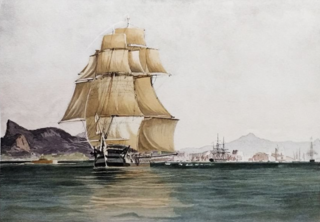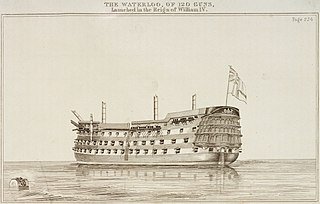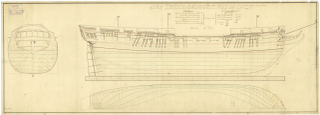HMS Vanguard was a 74-gun third-rate ship of the line of the Royal Navy, launched on 6 March 1787 at Deptford. She was the sixth vessel to bear the name.

HMS Colossus was a 74-gun third-rate ship of the line of the Royal Navy, launched from Deptford Dockyard on 23 April 1803. She was designed by Sir John Henslow as one of the large class 74s, and was the name ship of her class, the other being Warspite. As a large 74, she carried 24 pdrs on her upper gun deck, as opposed to the 18 pdrs found on the middling and common class 74s. She took part in the Battle of Trafalgar, and was broken up in 1826.

The Spartiate was originally a French 74-gun ship of the line, launched in 1797. In 1798, she took part in the Battle of the Nile, where she became one of the nine ships captured by the Royal Navy.

HMS Hannibal was a 74-gun third-rate ship of the line of the Royal Navy, launched on 15 April 1786, named after the Carthaginian general Hannibal. She is best known for having taken part in the Algeciras Campaign, and for having run aground during the First Battle of Algeciras on 5 July 1801, which resulted in her capture. She then served in the French Navy until she was broken up in 1824.

Admiral Sir Henry William Bayntun GCB was a senior officer in the Royal Navy, whose distinguished career in the French Revolutionary and Napoleonic Wars was a catalogue of the highest and lowest points of the Navy during the conflict. His record includes extensive operations in the West Indies followed by shipwreck, the battle of Trafalgar and the disastrous expedition to Buenos Aires in 1807.

HMS Foudroyant was an 80-gun third rate of the Royal Navy, one of only two British-built 80-gun ships of the period. Foudroyant was built in the dockyard at Plymouth Dock and launched on 31 March 1798. Foudroyant served Nelson as his flagship from 6 June 1799 until the end of June 1800.

HMS Caledonia was a 120-gun first-rate ship of the line of the Royal Navy, launched on 25 June 1808 at Plymouth. She was Admiral Pellew's flagship in the Mediterranean.

HMS Saturn was a 74-gun third-rate ship of the line of the Royal Navy, launched on 22 November 1786 at Northam. The vessel served during the Napoleonic Wars with the Channel Fleet, taking part in the 1801 Battle of Copenhagen. With the beginning of the War of 1812, Saturn was modified to become a frigate designed to take on large American vessels of that type. Saturn was deployed as part of the blockading squadron of New York City from 1814 to 1815. From 1825, the vessel was in harbour service and was broken up in 1868.
HMS Bedford was a Royal Navy 74-gun third rate. This ship of the line was launched on 27 October 1775 at Woolwich.

HMS Waterloo was a 120-gun first-rate ship of the line of the Royal Navy, launched on 10 June 1833 at Chatham.

HMS President was a large frigate in the British Royal Navy (RN). She was built to replace the previous HMS President, redesignated from the heavy frigate USS President built in 1800 as the last of the original six frigates of the United States Navy under the Naval Act of 1794. The first President had been the active flagship of the U.S. Navy until captured while trying to escape the Royal Navy blockade around New York in 1815 at the end of the War of 1812, and then served in the RN until broken up in 1818. The new British President was built using her American predecessor's exact lines for reference, as a reminder to the United States of the capture of their flagship – a fact driven home by President being assigned as the flagship of the North America and West Indies Station in the western Atlantic Ocean under the command of Admiral Sir George Cockburn (1772–1853), who had directed raids throughout the Chesapeake Bay in 1813–1814 that culminated in the 1814 burning of official buildings in the American capital, Washington, D.C.

Admiral of the Fleet Sir George Martin was an officer of the Royal Navy who saw service during the American War of Independence, and the French Revolutionary and Napoleonic Wars. During his long naval career he took part in several significant battles, for which he was awarded a number of honours and promotions; he commanded ships at Cape St Vincent and Cape Finisterre.

HMS Malta was an 80-gun third rate ship of the line of the Royal Navy. She had previously served with the French Navy as the Tonnant-classGuillaume Tell, but was captured in the Mediterranean in 1800 by a British squadron enforcing the blockade of French-occupied Malta. Having served the French for less than four years from her completion in July 1796 to her capture in March 1800, she would eventually serve the British for forty years.
Admiral Sir Lawrence William Halsted GCB was an officer of the Royal Navy who served during the American War of Independence and the French Revolutionary and Napoleonic Wars.

HMS Winchester was a 60-gun Southampton-class sailing frigate of the Royal Navy. She was laid down in 1816 at Woolwich Dockyard, and launched on 21 June 1822. Although designed for 60 guns, she and the rest of her class carried 52 guns. From 1831 to 1861 she served in North America and Southeast Asia. In 1861 she became the training ship Conway at Liverpool, and from 1876 she was the training ship Mount Edgcumbe. She was sold in 1921.
Rear-Admiral Edward Sneyd Clay was an officer of the Royal Navy who served during the American War of Independence, and the French Revolutionary and Napoleonic Wars.

Rear-Admiral John Bligh CB was an officer in the Royal Navy who served during the American War of Independence and the French Revolutionary and Napoleonic Wars.
Admiral Thomas Le Marchant Gosselin was a British naval officer of the 18th and 19th centuries who received the patronage of senior officers such as Samuel Hood, 1st Viscount Hood and William Cornwallis. Gosselin joined the Royal Navy in 1778 and as a junior officer had extensive service in the American Revolution, including participating in the Battle of the Saintes in April 1782. Promoted to commander in April 1793, Gosselin took part in the Glorious First of June as commander of HMS Kingfisher. He was promoted to post-captain in July 1795 and took command of a variety of ships including most notably HMS Syren, HMS Latona, and HMS Audacious. Gosselin frequently served on blockade duties in the English Channel and on convoy duties to and from the West Indies.

The Thames-class frigate was a 32-gun fifth-rate frigate class of eight ships of the Royal Navy based on the Richmond-class frigate designed by William Bately. The ships were ordered to the older design, which was of a smaller type of ship compared to more modern designs, so that they could be built quickly and cheaply in time to assist in defending against Napoleon's expected invasion of Britain. The class received several design changes to the Richmond class, being built of fir instead of oak, with these changes making the class generally slower and less weatherly than their predecessors, especially when in heavy weather conditions. The first two ships of the class, Pallas and Circe, were ordered on 16 March 1804 with two more ordered on 1 May and the final four on 12 July. The final ship of the class, Medea, was cancelled on 22 October before construction could begin but the other seven ships of the class were commissioned between 1804 and 1806.
Vice-Admiral Philip Wodehouse was a Royal Navy officer. A son of John Wodehouse, 1st Baron Wodehouse, he joined the navy some time before 1794. In 1796 he was promoted to commander and then captain, commanding sloops and frigates in the Mediterranean Fleet. Wodehouse cycled through a series of frigate commands towards the end of the French Revolutionary Wars, including HMS Mignonne which he had to burn as useless in 1797. In 1803, while commanding HMS Resistance, his ship was wrecked off Cape St Vincent. Wodehouse subsequently commanded several ships of the line, including HMS Cumberland in the Mediterranean where in 1809 he fought at the Battle of Maguelone. Wodehouse was appointed Resident Commissioner, Halifax, in 1811 and served there until the dockyard was closed in 1819. He was promoted to rear-admiral later in the year. Wodehouse saw no further active service, but was promoted to vice-admiral in 1830.



![The burning of the Training-Ship 'Warspite' off Woolwich, sketched [by Walter William May] on the Day of the Disaster - from an 1876 issue of The Graphic. The Burning of the Training-Ship 'Warspite' off Woolwich, sketched on the Day of the Disaster - The Graphic 1876.jpg](http://upload.wikimedia.org/wikipedia/commons/thumb/3/36/The_Burning_of_the_Training-Ship_%27Warspite%27_off_Woolwich%2C_sketched_on_the_Day_of_the_Disaster_-_The_Graphic_1876.jpg/220px-The_Burning_of_the_Training-Ship_%27Warspite%27_off_Woolwich%2C_sketched_on_the_Day_of_the_Disaster_-_The_Graphic_1876.jpg)













